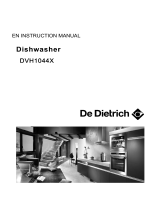
To review the section on troubleshooting Tips
will help you to solve some common problem s
by yourself .
Dea r Customer,
Please care fully rea d thi s manual bef ore using the
dishwasher, it will help you use and maint ain the
dishwasher properly.
Pass it on to any sub sequent owner of the appl ianc e.
This ma nual con tains sections on safety In structions,
Ope rating Instru ctions, In stal lation Ins truc tion s an d
Trou bleshoo ting Tips, etc.
The manufacture r, following a policy of constant
dev elopment and updating of the product, may
make modifications without giving prior notice.
If lost or out-of-date, you can receive a new user
manual from the manufa cturer or respon sible
vendor.
Keep this manual for future reference.
If you can not solv e the problems by yourself ,
please ask for the help of professional technicians.
1) Safety Instructions.....................................1-4
2) Quick user guide.................... .................. ....5
3) Operating Instructions..... ............ ............ ....6
4) Prior to first time use....................................7
5) Preparing and loading dishes............ .........12
6) Starting a washing program... .................. ..14
7) Maintenance and cleaning........... ...............16
8) Installation Instruction................ ...............18
9) Troubleshooting Tips.................................21
Loading the baskets according t o En50242
Control Panel............ ........................................6
Dishwasher Features.........................................6
A.Water Softener..................................... ..........7
B.Loading the Salt into the Softener....................8
C.Filling the Rinse Aid Dispenser.............. ..........8
D.Function of Detergent......... ............................9
Recommendations for loading and unloading
the dishwasher................................................12
Standard loading pattern..................................13
Wash Cycle Table.................. ............ ............ ..14
Turning on the Appliance........ .................. ........14
Changing the Program mi d-cycle......................15
At the end of the Wash Cycle.............................15
Filter System................................................ ...16
Caring for the Dishwasher.................. ...............17
Positioning the Appliance.................................18
About Power Connection............. .....................18
Water connection.............................................19
Start of dishwasher.... ........... ...........................20
Before calling for service............. .....................21
Error codes .............. .................. ............ ........22
Technical information.................. .................. ...23





















